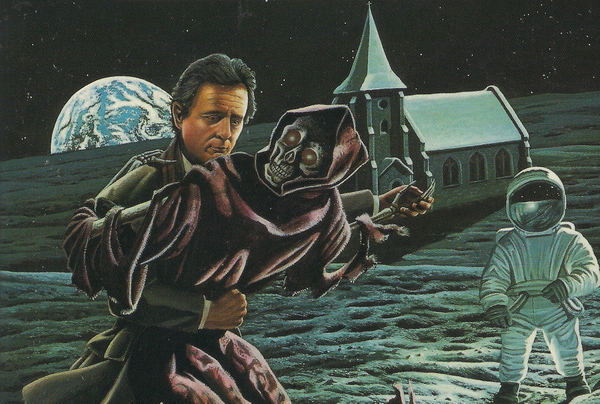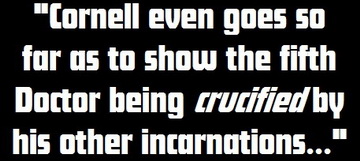|
| |
|
STORY PLACEMENT THIS STORY TAKES
PLACE BETWEEN THE APOCALYPSE" AND "CAT's CRADLE: TIME'S CRUCIBLE."
WRITTEN BY PAUL CORNELL
RECOMMENDED PURCHASE OFFICIAL VIRGIN 'NEW ADVENTURE' PAPERBACK (ISBN 0-426-20360-7) RELEASED IN DECEMBER 1991.
BLURB The parishoners of Cheldon Bonniface walk to church on the Sunday before Christmas, 1992. Snow is in the air, or is it the threat of something else? The Reverend Trelaw has a premonition, and discusses it with the spirit that inhabits his church. Perhaps the Doctor is about to visit them again?
Some years earlier, in a playground in Perivale, Chad Boyle picks up a half-brick. He’s going to get that creepy kid Dorothy who says she wants to be an astronaut. The weapon falls, splitting Dorothy’s skull. She IS KILLED instantly.
THE DOCTOR has FOUND THE TIMEWYRM AGAIN, but what MANNER OF TRANStemporal trap has SHE prepared for their final MEETING? |
|
|
Timewyrm: Revelation DECEMBER 1991
Paul Cornell’s climactic Timewyrm: Revelation is a remarkable book in so many ways. It neatly ties up the Timewyrm story arc, and in doing so it puts the Doctor and Ace through hell, at the end of the book leaving each of them much-changed characters. This a novel that truly lives up to the New Adventures’ mandate of creating stories that could never have been told on the small screen. It is, quite simply, a visual and psychological feast.
Cornell really let his imagination run wild in creating this thought-provoking masterpiece of a climax. The antagonists are a chilling bunch, the set pieces are on a scale far more epic than anything that the television series ever produced (a Church on the moon!), and finally - and most importantly - the character story is absolutely enthralling. The writer creates an adversary even more interesting than the Timewyrm, dragon-faced schoolboy bully Chad Boyle, or even returning Nazi Rupert Hemmings (from Timewyrm: Exodus): the Doctor’s own guilt.
Essentially, Revelation re-invents and revitalises the seventh Doctor. From Remembrance of the Daleks onwards, the Doctor was deliberately portrayed as a pro-active force against evil; a character that would seek out wrongdoing and do whatever he must to destroy that evil. Fair dues, he would always try to defeat his adversary using the power of words or his wits, but ultimately, if there was no other way, he would destroy the evil in whatever manner he could, short of picking up a weapon himself. Here, however, Cornell depicts the Doctor as being troubled by some of his recent actions, exploring his guilt over tricking Davros into destroying Skaro in particular.
within the surreal expanse of the Time Lord’s mind, Revelation affords us a glimpse of each of the Doctor’s past selves and their reactions to what the seventh Doctor has become. Whilst in previous multi-Doctor adventures the Doctor’s incarnations would all share a bit of banter but eventually get along, here they exist incorporeally within the mind of the current Doctor, each personality the sum of his own experiences; each conflicting opinion uninhibited by the reality’s social niceties. Cornell even goes so far as to show the fifth Doctor being crucified by his other incarnations in reprisal for the mistakes that he made. It’s powerful, lingering imagery to say the least. But at the end of this story comes a defining moment: inside the Doctor’s mind, Ace manages to escape a horde of dead UNIT soldiers and companions and free the fifth Doctor, expunging the Doctor’s guilt and giving him the freedom to look for other solutions to deal with evil.
“Supported by Ace, the fifth Doctor reached out, his hand closing on the stem of the flower. ‘I remembered what it was that you had lost, Doctor,’ he sighed. Then his voice became harder, more determined. ‘Now I return it to you.’”
Ace is also put through her own personal purgatory here. Cornell comes up with the macabre idea of having Ace’s childhood nemesis, a young schoolboy named Chad Boyle, pursue and terrorise her right the way through the Doctor’s mind. Possessed by the Timewyrm, the child is an unstoppable force and all Ace can do is fight, and fight, and fight – and lose every time. It’s one of the most terrifying concepts that I think I’ve come across in Doctor Who.
Moreover, Ace is forced to relive her days in Perivale before the Time Storm took her to Ice World and re-experience the racism that her friends endured, her traumatic relationship with her Mother, and much, much more besides. She even has to face her deepest fear: that the Doctor will betray her and leave her alone.
However, despite the outstanding character story – which by the way, is not limited to the Doctor and Ace. There is also a lovely little sub-plot featuring Saul (the living Church), the Reverend, and Emily and Peter Hutchings – Revelation is cloaked in an inspiring science-fiction conceit. In an effort to undermine history, the Timewyrm enters the mind of the young Chad Boyle and has him kill Ace whilst she is still a child. Immediately, this device has the reader hooked and it becomes increasingly hard to discern what is real – at one point it even seems that Ace is indeed dead and trapped in a child’s body inside some twisted version of hell.
Cornell also resolves the Timewyrm arc in a very satisfactory manner, the Doctor finding a way to deal with the threat without having to resort to the kind of heavy-handed tactics that have caused him such internal angst. Instead of destroying the Timewyrm completely, the Doctor is able to regress it to infancy and deposit its consciousness in the mind of a silent baby, which the Doctor inexplicably gave Emily Hutchings custody of in an earlier chapter, whilst apparently in a trance-like state. The story is then neatly tied up with a nifty little skit in which the Doctor looks after “the details with hindsight”. Realising that he dropped off a baby with Emily – an event that he remembers nothing of - he pops into the future, steals a genetically-engineered baby with an empty mind, travels back to the middle of the novel, strolls out of the TARDIS with his eyes closed, dumps the baby with Emily and then takes off again! Brilliant. One thing that often riles me about Doctor Who is how linear the stories tend to be, and so I particularly enjoyed Cornell’s imaginative and temporally-challenging ending.
And so the
Timewyrm was no more, and “Ishtar Hutchings” came to be; Ace found peace
with herself; and the Doctor was bestowed with the strange gift of
conscience. In just one novel, the debutant author turns the seventh
Doctor’s life completely around in a manner that feels anything but
contrived, and I can only applaud. This one is an absolute triumph.
|
|
|
Copyright © E.G. Wolverson 2006
E.G. Wolverson has asserted his right under the Copyright, Designs and Patents Act, 1988 to be identified as the author of this work. |
|
|
Unless otherwise stated, all images on this site are copyrighted to the BBC and are used solely for promotional purposes. ‘Doctor Who’ is copyright © by the BBC. No copyright infringement is intended. |
|

.jpg)
.jpg)

 As the bulk of
the narrative takes place
As the bulk of
the narrative takes place